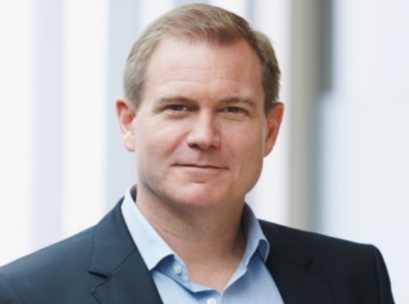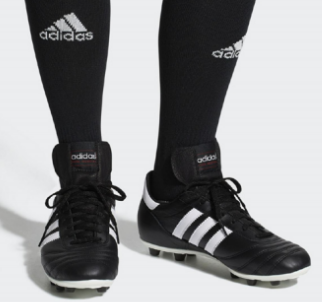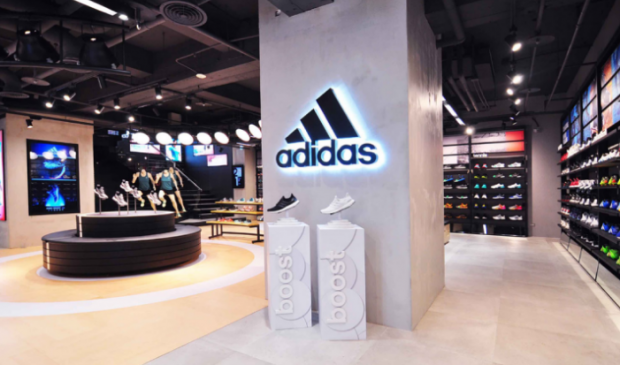 BIO: Steve Castledine was appointed to the role of Adidas general manager Pacific – Australia and New Zealand – in 2014, and since then has seen the brand grow from strength to strength in all areas of the business. Prior to running Adidas in the region, Castledine held various executive positions with Levi Strauss & Co and Crocs in Australia, New Zealand and Asia Pacific.
BIO: Steve Castledine was appointed to the role of Adidas general manager Pacific – Australia and New Zealand – in 2014, and since then has seen the brand grow from strength to strength in all areas of the business. Prior to running Adidas in the region, Castledine held various executive positions with Levi Strauss & Co and Crocs in Australia, New Zealand and Asia Pacific.
COMPANY PROFILE: Founded in 1949, Adidas is a multinational corporation based in Germany, which designs, manufactures and retails shoes, clothing and accessories. Adidas operates in Australia via wholesale and retail channels, with a mix of mono-brand and franchise stores. The sports giant opened its first local franchise door in December 2016 with Zorich Group, who continue to operate the brand exclusively within the South Australian market. Adidas Australia’s footprint is set to expand following a recently signed agreement with Melbourne-based group, Atomic Group.
Inside Retail Weekly: How has the last 12 months been for the Adidas, what are some of the highlights?
Steve Castledine: About a month ago, we published our global financial results for 2017, which highlighted 16 per cent of top line growth globally and some nice improvements in operating income, plus areas of investment globally around our US and China businesses.
I’m pleased to say that business in Australia during the same period, was slightly better than that. We are showing strong double-digit growth in the Australia and New Zealand markets on the back of continued growth in our key footwear franchises and great partnerships with our retail partners here in Australia, which have gone from strength to strength.
By all accounts, we had an outstanding year in 2017 and really excited as we are now already four months into this year.
IRW: In terms of the split between wholesale and retail, can you tell us a little bit about how you operate in the local marketplace?
SC: We are predominantly a wholesale business in Australia, so mainly focus on selling into retail trade partners across a spectrum of market segments. From sporting goods, which includes the likes of Rebel and Intersport, through to sneaker and sport fashion businesses, which is companies like Hype and Platypus.
Finally, it’s selling into the global players in market, which includes Footlocker and JD Sports, who is the new market entrant.
IRW: Consumers have really lapped up that JD Sports experience haven’t they?
SC: Yes, customers in Australia have enjoyed JD being in market. Certainly for the sneakerheads, they feel JD is bringing them a different sort of feel to brands and to the shopping experience. It’s a more integrated approach, when you look at how they connect their online business with in-store and offer a broader assortment through e-commerce.
They’re at eight stores now so it’s relatively early days, but certainly, they are one of the few retailers in our space within the market that is significantly expanding from a standing start. I don’t know any other retailers in this category that are aggressively opening stores today in Australia.
IRW: Let’s segue way into the sports sector more broadly, what are some insights into how the category is performing in Australia?
SC: The market data that we access suggests that sports retailing is performing similarly to the general clothing and footwear sector, with the exception of the sneaker category which has shown more buoyant growth performance over the past three years.
This would be confirmed if you looked at the Accent Group’s performance across Platypus and Hype for example, and their year-on-year growth over the last couple of years would have significantly outperformed general footwear and general apparel.
But if you look at the half-year report that came out six or eight weeks ago from Super Retail Group, Premier Investments and Myer, those comp door sales growth numbers are sitting between the one and two per cent range and really all the growth is occurring through new doors and renovated doors.
If you’re in the general goods sporting space, you’re probably in that low to mid single-digit growth area, but in the sneaker space you’re probably doing a bit better than that.
IRW: What are your thoughts on the importance of brand heritage in today’s marketplace?
Consumers are responding to brands first and foremost. There are lots of examples of products that are in the marketplace, which are attempting – from a design standpoint – to mimic what brands like Adidas, Nike and Puma are doing in market, with pretty limited success.
Consumers are savvy enough to understand that brands themselves are the ones delivering true innovation in design and functionality. That’s what consumers want and are willing to spend money on. And we see that by how they’re responding to new product launches. Some of this is product that is not aggressively marketed locally.
The consumer is generally accessing information online and through various forums, social media networks, about new product launches as they’re hitting the market globally.
This generates a lot of local demand; at global product launches in the fashion and sneaker space, queues will appear outside our doors that we did very little to actually generate from a marketing standpoint.
They would have been generated by the global hype for those products, whether it’s a new Kanye West Yeezy launch or a Pharrell Williams launch or one of our other collaborations.
Consumers are tapping into information on their own because they’re participating in social forums, tapping into online sites such as Hypebeast, Highsnobiety, Sneakerfreaker and informing themselves.
So that tells me consumers are looking for newness and innovation from their brands.
IRW: In the case of Adidas – who are obviously massive – does heritage help or hinder the company when looking to innovate or do something new?
SC: People buy brands fundamentally because they trust brands. From a design standpoint, they trust their brand is giving them the latest in design, colour and materials. They also buy brands and trust brands because of the promise of quality and that the product is going to perform as it’s advertised to.
People also want to be seen wearing that brand because it forms a part of who they are and the statement they want to make to their friends and the world in general. So that’s why brands are important.
From our perspective as the founding brand in sporting goods, we’ve gone through a really interesting evolution from the early days – when literally everybody wore Adidas and everybody has a great story to tell about their first pair of Adidas shoes – through to a period where the brand was not as cool, where there were other brands that were entering the market.
Certainly the emergence and then proliferation of brands like Nike, Puma, Reebok and others, presented a challenge for Adidas in its traditional role as the founder of the category. But we’ve been able to actually play our heritage back as a strength.
And a lot of our more innovative products, from a design standpoint, actually have design cues that relate back to products from our heritage. But we’re able to give it an authenticity because of our heritage that underpins some of the design credentials of the products. Because it’s that authenticity that I think makes our heritage valuable to us.
 IRW: That reminds me of my own experience buying soccer boots and although the new Predator model comes out every year, I still find myself buying the old school Copa Mundials that go back to the 1970s…
IRW: That reminds me of my own experience buying soccer boots and although the new Predator model comes out every year, I still find myself buying the old school Copa Mundials that go back to the 1970s…
SC: That’s the reason why the Copa Mundial is still available in Australia because we recognise there are consumers like you that love the product, trust and grew up with that product.
IRW: How has e-commerce impacted the sports space?
SC: Within the sporting goods market in Australia, one of the challenges is around overseas online products being imported into the country. We’ve had legislation for a year that’s been sitting with the government to implement a lower GST threshold on overseas online shipments into Australia and the government has yet to pass that legislation.
That’s very frustrating because we continue to have the highest sales threshold of any of the developed countries in the world for online overseas purchases being imported into the market. It needs to change because it challenges our local ability to compete.
I’m hopeful that the government will pass that legislation finally in July as promised. At the moment, overseas online retailers get a 15 per cent free kick into this market and as much as the consumer still has to wear the cost of shipments and currency exchange rate variations, overseas online operators are getting a 15 per cent free kick on top of that and it’s not helping our local environment or helping us to compete.
And what consumers don’t understand is, if they bought a product outside this market then they are literally on their own. If someone rings me and says, ‘Oh I bought this product online but it’s defective or I’m not happy with it,’ there’s really not much I can do for them.
They didn’t purchase it from us or from one of our customers and that’s disappointing for them when they hear that and it’s also disappointing for us. Fundamentally you take a risk when you’re buying product from a website overseas. So that’s a challenge.
As far as online generally, it’s a big opportunity. There’s no denying the fact that online will continue to grow faster than bricks-and-mortar and will continue to be a larger share of retail sales in Australia. We should be prepared and catering for that, and should be supporting our customers and our own direct-to-consumer business.
That’s what we’re doing, supporting Rebel and Footlocker’s online business, our own online business and the pure players that are in market and doing very well such as The Iconic, Stylerunner and Surfstitch.
It’s a channel that we’re servicing with a different model than the traditional bricks-and-mortar model, but it’s exciting and gives us lots of opportunity to engage with consumers.
Not just with purchasing a product but also through digital content and providing the consumer access to the story or the athlete behind the products. It gives the consumer a more holistic and consistent experience with the brand because they’re accessing it through digital media, as oppose to relying on an in-store environment to do that work for us.
From a brand perspective, it gives us a stronger connection to the consumer.
IRW: Speaking of the consumer, how have Aussies responded to the mono-branded Adidas stores?
SC: We have a relatively small number stores in market but they’ve gone very well and we’re really encouraged by the way that the consumer engages with our brand in the mono-branded environment.
We operate two different formats in the market. We have an Adidas performance format, which focuses on primarily on running and training and football and then we have an originals store format, which is more on the sports fashion and sneaker side of the business.
We are quite careful on how we deploy both of those concepts into market in the major centres across Australia. And we’ve found that in all the centres we’re in, that the consumers are engaging with our stores, the stores are performing well and we’re able to give the consumer an experience because of the breadth of offer and imagery that the environment holds.
We are able to give them an experience with the brand that they won’t get somewhere else, just because it’s a mono-branded environment.
 IRW: What are Adidas’ expansion plans in the short to mid-long term for Australia.
IRW: What are Adidas’ expansion plans in the short to mid-long term for Australia.
SC: We reached a point in our development where we recognised that there is an opportunity for more mono-branded stores in the market. But in order for us to pursue that through our own retail perspective, it would require significant infrastructure investment to operate those stores.
All of our own stores in Australia operate along the eastern seaboard. We don’t operate concept stores west of Melbourne really.
For us to be truly national and take advantage of the opportunity that we see in the market for a mono-branded environment, we were faced with a decision – do we want to significantly invest in infrastructure so that we have the operational footprint to operate stores nationally, and in New Zealand, or do we think that it’s more appropriate for us to pursue that expansion through a franchise partner?
Now we have already got a franchise partner in Adelaide, where we operate with the Sportspower trade partner, the Zorich Group and have a successful original store with Tom and Judy Zorich based in Rundle Mall.
So we know that works and that’s our proof of concept for us. That store’s about 15 months old now and we felt it was time for us to make decisions on whether or not we expanded around Australia with that similar model.
Through Tom Kiing and the Sportsco Group we will identify over the course of the next five or six years, an opportunity for to expand retail into centres and cities that don’t currently have a mono-branded retail store.
We don’t plan to close our own stores or convert our own stores to franchise, we plan to open stores in new centres, new cities where our mono-brand footprint is not as developed and there are plenty of those opportunities.
We haven’t yet finalised specific plans in terms of a roll-out, we’ve literally just signed the agreement less than two weeks ago and so that process was really more about selecting the right franchise partner.
New stores are dependent on locations being available and so we need to sit down with Tom and agree where we want to focus our first few stores and make sure that we can secure locations that we’re satisfied with.





